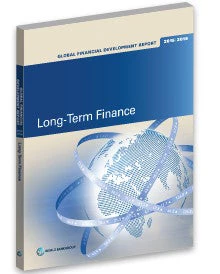
In fact, ensuring more and better long-term finance has become one of the priorities for the post 2015-Agenda (United Nations 2013). Concerns about the detrimental development effects of a potentially constrained supply of long-term finance have been voiced in the Group of Twenty (G-20) meetings and by the Group of Thirty and ensuring more and better long-term finance is one of the priorities for the post 2015-Agenda (United Nations 2013). This year’s Global Financial Development Report (GFDR), the third in the series, is a synthesis of recent and ongoing research aiming to identify those policies that work to promote long-term finance and those that do not, as well as areas where more evidence is still needed.
Here are some interesting stylized facts from the report:
The use of long-term finance—frequently defined as all financing for a time frame exceeding one year—is more limited in developing countries, particularly among smaller firms and poorer individuals. Where it exists, the bulk of long-term finance is provided by banks; use of equity, including private equity, is limited for firms of all sizes. As financial systems develop, the maturity of external finance also lengthens. For example, in developing countries, small firms’ long-term debt-to-asset ratios are 1 percent, compared with 7 percent in high-income countries. Firms in high-income countries report financing almost 40 percent of their fixed assets externally, whereas this figure is barely 20 percent in low-income countries. Similar differences exist for individuals’ use of long-term finance. The average share of individuals with an outstanding loan to purchase a home is 21 percent in high-income countries, yet barely 2.5 percent in lower-middle- and low-income countries.
The global financial crisis of 2008 made the problem even worse in some cases. The use of long-term finance by small and medium enterprises in developing countries fell by almost half following the crisis. We also saw a massive drop in syndicated lending, one of the main sources of financing for infrastructure projects.
Developing countries have made significant progress over the last two decades in developing local financial markets and tapping into international capital markets, but this hasn’t been enough to close the long-term finance gap. This is because only very few large firms access finance through equity or bond markets.
The report distills a large body of evidence to come up with recommendations for policymakers.
To be sure, long-term finance is not always optimal: its use in an economy reflects the risk-sharing between users and providers of finance, given the overall economic environment. But when this use is limited due to market failures and policy distortions, such as limited information, poor contract enforcement, macro instability, and the like, it is important for policies to address these. Otherwise, the maturity of available finance will be short because such distortions have a disproportionate effect on long-term finance. And this matters: If long-term finance is not available for deserving firms, they become exposed to rollover risks and may become reluctant to undertake longer-term fixed investments, with adverse effects on economic growth and welfare. Without long-term financial instruments, households cannot smooth income over their life-cycle—for example by investing in housing or education—and may not benefit from higher long-term returns on their savings. Hence sustainably extending the maturity structure of finance is a key policy challenge since long-term finance can be an important contributor to economic growth and welfare.
So what should governments do? The main message of the report is that there is no magic bullet to promote long-term finance: governments need to focus on fundamental institutional reforms. These include pursuing policies that promote macroeconomic stability, low inflation, and viable investment opportunities; promoting a contestable banking system with healthy entry and exit supported with strong regulation and supervision; putting in place a legal and contractual environment that adequately protects the rights of creditors and borrowers; fostering financial infrastructures that limit information asymmetries; and laying the necessary institutional and incentive frameworks to facilitate long-term development of capital markets and institutional investors. These are likely to improve financial development in general, but will extend the maturity structure of finance in particular. The report provides many examples of how such interventions improved availability and use of long-term finance.
But these all take time. In the medium term, market-friendly innovations may help extend maturity. Asset-based lending instruments like leasing can help smaller companies get access to long-term finance. Larger firms often rely more on international finance, so they may benefit from opening up to foreign investors. Financial literacy may help individuals and small firms better understand the terms of the complicated financial instruments, making sure increased use of long-term finance is also sustainable.
A large body of research suggests that direct efforts to promote long-term finance by governments and development banks—such as directed credit or subsidy programs—have not been successful. This is because the underlying institutional problems and market failures behind the low use of long-term finance often remain and political capture and poor corporate governance practices lead to inefficient allocation of resources and result in large costs for the taxpayers in the long run.
A more promising avenue for policy interventions is to put in place well designed, incentive compatible, private-public risk-sharing arrangements. Such arrangements—such as for example public-private partnerships for large infrastructure projects—hold promise for mobilizing financing for long-term projects by crowding in private finance and improving performance by subjecting it to market discipline.
There is much more in the report and the background papers, as well as several updates of major datasets on financial systems, all available at http://www.worldbank.org/financialdevelopment. Stay tuned for further blog posts that will delve further into the findings and data from the individual chapters of the report.
References:
United Nations Task Team on the Post-2015 UN Development Agenda, 2013. Financing for Sustainable Development in the Global Partnership beyond 2015. New-York: United Nations.
World Bank, 2015, Global Financial Development Report 2015-2016: Long-Term Finance. Washington, DC: World Bank.



Join the Conversation